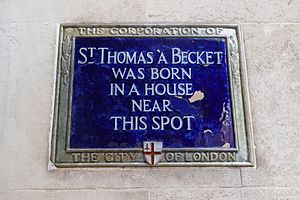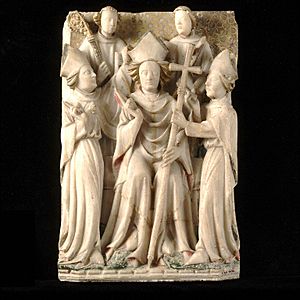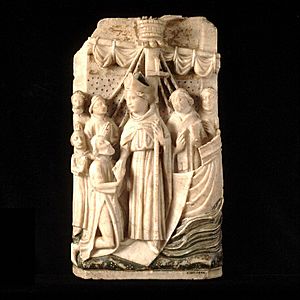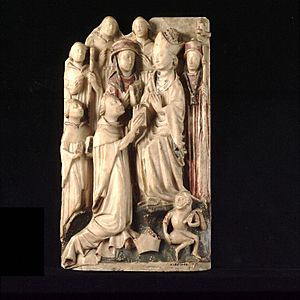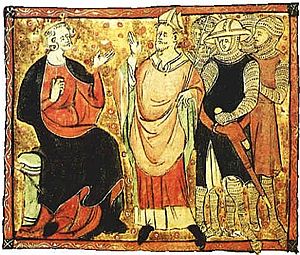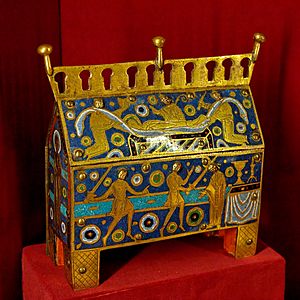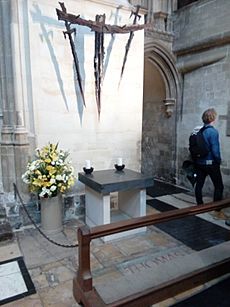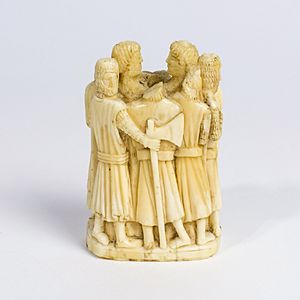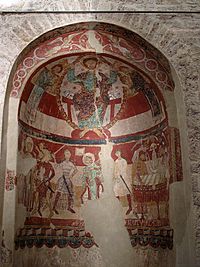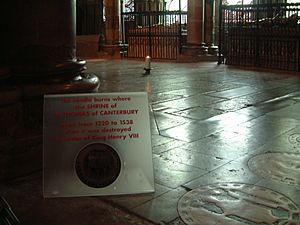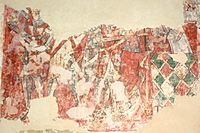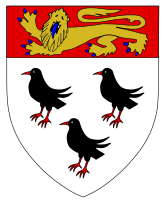Thomas Becket facts for kids
Quick facts for kids Saint Thomas Becket |
|
|---|---|
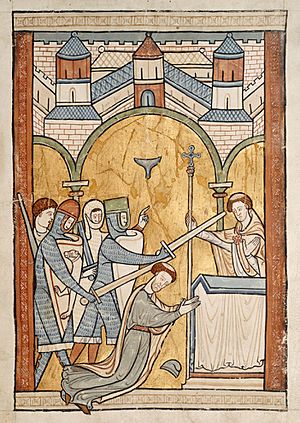
One of the earliest known depictions of Becket's assassination, c. 1175–1225
|
|
| Church | Latin Church |
| Archdiocese | Canterbury |
| See | Canterbury |
| Appointed | 24 May 1162 |
| Reign ended | 29 December 1170 |
| Predecessor | Theobald of Bec |
| Successor | Roger de Bailleul (Archbishop-elect) |
| Orders | |
| Ordination | 2 June 1162 |
| Consecration | 3 June 1162 by Henry of Blois |
| Personal details | |
| Born | 21 December c. 1119 Cheapside, London, Kingdom of England |
| Died | 29 December 1170 (aged 50 or 51) Canterbury Cathedral, Kent, Kingdom of England |
| Buried | Canterbury Cathedral |
| Denomination | Catholicism |
| Parents |
|
| Previous post |
|
| Coat of arms |  |
| Sainthood | |
| Feast day | 29 December |
| Venerated in | |
| Beatified | by Pope Alexander III |
| Canonized | 21 February 1173 by Pope Alexander III |
| Attributes | |
| Patronage |
|
| Shrines | Canterbury Cathedral |
| Cult suppressed | 1538 (by Henry VIII) |
Thomas Becket (born 21 December 1119 or 1120 – died 29 December 1170) was an important English nobleman. He worked as the Lord Chancellor from 1155 to 1162. After that, he became the Archbishop of Canterbury in 1162. He was killed in 1170.
Becket is seen as a saint and a martyr by the Catholic Church and the Anglican Communion. He had a big disagreement with King Henry II of England. This fight was about the rights of the Church. He was murdered by some of the king's followers in Canterbury Cathedral. Soon after his death, Pope Alexander III made him a saint.
Contents
Thomas Becket's Early Life
Becket was born in London around 1119 or 1120. His birthday was 21 December, which is the feast day of St Thomas the Apostle. His parents were Gilbert and Matilda Becket. His father, Gilbert, was a merchant. He owned property in London and was once a sheriff of the city.
When Thomas was 10, he went to study at Merton Priory. Later, he attended a grammar school in London. He also spent about a year studying in Paris.
After some financial problems for his family, Becket had to find work. He became a clerk. He later got a job working for Theobald of Bec, who was the Archbishop of Canterbury.
Theobald sent Becket on important trips to Rome. He also sent him to study canon law (church law) in Bologna and Auxerre. In 1154, Theobald made Becket the Archdeacon of Canterbury. He also held other church jobs.
Becket was very good at his work. Because of this, Theobald suggested him to King Henry II. In January 1155, Becket became the King's Lord Chancellor.
As Chancellor, Becket made sure the king collected taxes from everyone. This included churches and bishops. King Henry even sent his son, Henry the Young King, to live in Becket's home. This was a common custom for noble children back then.
Becoming Archbishop of Canterbury
Becket was chosen to be the Archbishop of Canterbury in 1162. This happened a few months after Theobald died. Bishops and noblemen confirmed his election on 23 May 1162. King Henry might have hoped Becket would keep supporting the king's government. But Becket changed a lot and became very religious.
- Becket enthroned as Archbishop of Canterbury from a Nottingham Alabaster in the Victoria & Albert Museum
Becket became a priest on 2 June 1162 in Canterbury. The next day, he was made archbishop by Henry of Blois, the Bishop of Winchester.
A disagreement grew between King Henry and Becket. The new archbishop quit his job as Chancellor. He wanted to get back and expand the rights of the Church. This led to many conflicts with the King. One big fight was about whether church courts or royal courts should judge English clergymen. This made the King and Becket dislike each other even more.
King Henry tried to get other bishops to go against Becket. This started in Westminster in October 1163. The King wanted approval for the traditional rights of the royal government over the church. This led to the Constitutions of Clarendon.
The Constitutions of Clarendon
King Henry II held meetings with most of the English church leaders. These meetings were at Clarendon Palace on 30 January 1164. In 16 new rules, he wanted the church to have less independence. He also wanted weaker connections with Rome.
Henry tried to get everyone to agree, and most did, except Becket. Finally, even Becket said he would agree to the main ideas of the Constitutions of Clarendon. But he still refused to officially sign the documents.
Henry called Becket to appear before a big council. This was at Northampton Castle on 8 October 1164. Becket had to answer charges of disrespecting the king and doing wrong as Chancellor. Becket was found guilty. He then stormed out of the trial and ran away to Europe.
Henry tried to catch the archbishop by issuing new rules. These rules targeted Becket and his friends. But King Louis VII of France offered Becket protection. Becket stayed for almost two years at Pontigny Abbey. Henry's threats against the abbey made him move to Sens.
Becket fought back by threatening to remove the king and bishops from the church. But Pope Alexander III wanted a more peaceful solution. In 1167, the Pope sent officials to help settle the dispute.

In 1170, the Pope sent more people to find a solution. At that point, Henry offered a deal that would let Thomas return to England.
The Assassination of Thomas Becket
In June 1170, Roger de Pont L'Évêque, the Archbishop of York, crowned King Henry's son, Henry the Young King. This was against the special right of Canterbury to perform coronations. So, in November 1170, Becket removed all three bishops involved from the church.
When King Henry heard about Becket's actions, he said something that his men understood as a wish for Becket to be killed. The exact words are not certain. One common saying, though likely made up later, is "Will no one rid me of this turbulent priest?" A writer from that time, Edward Grim, said Henry actually said, "What miserable drones and traitors have I nourished and brought up in my household, who let their lord be treated with such shameful contempt by a low-born cleric?"
Whatever Henry said, his knights took it as a command. Four knights, Reginald FitzUrse, Hugh de Morville, William de Tracy, and Richard le Breton, went to Canterbury. On 29 December 1170, they arrived at Canterbury Cathedral.
Eyewitnesses said the knights left their weapons outside. They went in to challenge Becket. They told him to go to Winchester to explain his actions. Becket refused. Only when he refused their demands to obey the king did they get their weapons. They rushed back inside to kill him. When Becket saw them, he said, "I am no traitor and I am ready to die."
After Becket's Death
After Becket was killed, monks prepared his body for burial. Some stories say he was wearing a rough hairshirt under his archbishop's clothes. This was a sign of his deep religious devotion.
Soon, people across Europe began to see Becket as a martyr. On 21 February 1173, just over two years after his death, Pope Alexander III made him a saint. In 1173, Becket's sister Mary became the head of Barking Abbey. This was a way to make up for her brother's murder.
On 12 July 1174, King Henry humbled himself at Becket's tomb. He did public penance there. Becket's tomb became a very popular place for pilgrims.
Becket's killers went north to Knaresborough Castle. They stayed there for about a year. The Pope removed all four knights from the church. To get forgiveness, the knights traveled to Rome. The Pope ordered them to serve as knights in the Holy Lands for 14 years.
The monks were worried Becket's body might be stolen. So, his remains were placed under the floor of the cathedral's eastern crypt. In 1220, Becket's bones were moved to a new, fancy shrine. This shrine was gold-plated and covered in jewels. It was placed behind the main altar in the Trinity Chapel.
Becket's Fame in the Middle Ages
In Scotland, King William the Lion ordered Arbroath Abbey to be built in 1178. When it was finished in 1197, it was dedicated to Becket. The king had known Becket personally when he was young.
On 7 July 1220, 50 years after his death, Becket's remains were moved. They went from his first tomb to a new shrine in the Trinity Chapel. This event was very important for the English Church. King Henry III and many other important people attended.
A new special day was created to remember this event. It was celebrated every July in England and France. However, it was stopped in 1536 during the Reformation.
King Henry VIII ordered the shrine to be destroyed in 1538. He also had Becket's bones destroyed. He commanded that Becket's name be removed from all records.
Becket was seen as a hero by the people of London. He was adopted as London's co-patron saint with St Paul. Both appear on the city's official seals.
Local stories about Becket became popular after he became a saint. For example, "Becket's Well" in Otford, Kent, is said to have appeared after Becket struck the ground with his crozier. He was unhappy with the taste of the local water. Another story says nightingales do not sing in Otford because Becket told them not to. He was disturbed by their singing during his prayers.
Becket's fame quickly spread. The first holy image of Becket is a mosaic in Monreale Cathedral in Sicily. It was made soon after his death. Marsala Cathedral in western Sicily is also dedicated to Becket.
Becket's Legacy and Influence
- In 1170, King Alfonso VIII of Castille married Eleanor Plantagenet. She was King Henry II's daughter. She honored Becket with a wall painting of his death. This painting is still in the church of San Nicolás de Soria in Spain.
- Geoffrey Chaucer's famous book, The Canterbury Tales, tells the story of pilgrims. They walk from Southwark to Becket's shrine in Canterbury Cathedral.
- The story of Becket's life was a popular subject for medieval carvers. You can see some of these carvings in the Victoria and Albert Museum.
- The official coat of arms for the City of Canterbury uses symbols from Thomas Becket. It shows three Cornish choughs. It also has a lion from the Royal Arms of England.
- In 1884, the poet Alfred, Lord Tennyson wrote a play called Becket. It was about Thomas Becket and Henry II.
- Many modern plays and books are based on Becket's story. These include T. S. Eliot's play Murder in the Cathedral and Jean Anouilh's play Becket.
- The Becket Fund for Religious Liberty is a group that works for religious freedom. They were inspired by Thomas Becket.
- Many churches in the UK are named after Thomas Becket. These include Cathedral Church of St Thomas of Canterbury, Portsmouth and St Thomas of Canterbury Church, Canterbury. There are also churches named after him in France.
- Part of the Hungarian city of Esztergom is named Szenttamás ("Saint Thomas"). It is on a hill dedicated to Thomas Becket. He was a classmate of Lucas, Archbishop of Esztergom in Paris.
- Thomas Becket is honored in the Church of England and the Episcopal Church on 29 December.
-
This wall painting shows Thomas Becket's martyrdom. It was painted in the 1330s in the church of St Peter ad Vincula, South Newington, Oxfordshire.
-
The coat of arms of the City of Canterbury uses symbols from Thomas Becket (three Cornish choughs) and the royal arms of England.
See also
 In Spanish: Tomás Becket para niños
In Spanish: Tomás Becket para niños
- Saint Thomas Becket, patron saint archive



